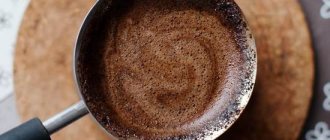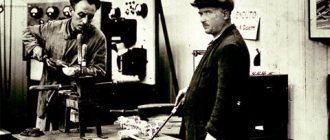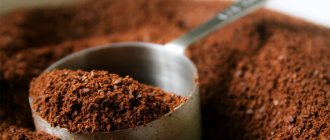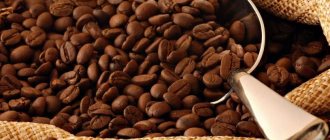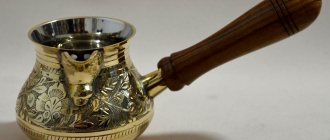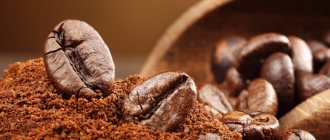Coffee is a refined and beloved drink by many, with a deep taste and unique aroma with a slight bitterness. To make this drink even more tasty and aromatic, various additives are added to it.
Some people believe that flavored coffee is harmful. However, this is not quite true. If you choose a quality product, it will not harm your health. Coffee with a light aroma of hazelnuts, vanilla, chocolate, citrus fruits, and liqueur is very popular.
What types of coffee are there?
All types and varieties of coffee can be divided into 4 main groups, by which the type of drink is determined. In particular, there are such varieties as:
- Arabica;
- robusta;
- excelsa;
- liberica.
Each group has its own specific properties and differs in grains and taste. Much depends on the country and area where it grows. The main varieties are Robusta and Arabica. Liberica and Excelsa have a very intense bitter taste, so they are added to other varieties to give a more original bouquet.
Arabica has a soft, delicate taste and contains a minimum of caffeine. The result is a pleasant drink with a light aroma. The coffee tree itself is very capricious. People highly value Arabica, which is grown only on mountain slopes.
Robusta is an unpretentious tree that can withstand temperature changes and depleted soil, while producing a large number of fruits. However, its beans contain quite a lot of caffeine, which imparts bitterness. But he also has admirers.
Features of flavored coffee
This is an interesting new product. Many people constantly add various spices and toppings in the form of milk and cream to this drink. Some even add orange zest. Coffee can be prepared in various ways, choosing the most delicious option for yourself.
It is quite possible to make an aromatic drink yourself by adding cloves, cinnamon, cardamom, and other herbs and spices. However, such complex flavors as amaretto, caramel and Turin chocolate are much more difficult to reproduce on your own. In this case, you can purchase flavored coffee.
Manufacturers produce it in different flavors. To produce flavored coffee beans, natural components, as well as substances obtained by chemical means, can be used. The difference is that the former have a softer and more natural taste, while the latter have bright and rich properties.
To produce flavored coffee beans, premium grade Arabica products of varying degrees of roasting are used, which are then saturated by spraying special additives on them. Sometimes only the grain packaging is processed. In this case, the coffee acquires only a slight aroma. The most important thing is to strictly follow the technology.
It is worth storing the grains in an airtight and dry container so that the aroma does not evaporate. It is better to grind them in a coffee grinder just before consumption in the required quantity.
What kind of coffee is flavored?
Having had enough of the flowery names of flavored coffee, it’s time to ask yourself the question - what types of coffee are generally processed in order to enhance or change the taste?
The question is not idle, if you remember the history of flavored grains.
- It is believed that they first appeared about 500 years ago. Natural flavorings included cloves, peppercorns, cinnamon, and vanilla.
- Spices were not used to pamper customers. They were needed to mask the musty taste and stale aroma of the grains.
We are far from thinking that modern producers use aromatic substances to correct the flaws of varieties or storage deficiencies, but we have never heard of elite and simply high-quality single varieties being aromatized.
On packages of flavored coffee you can usually see the inscription - 100% Arabica. But Arabica can be different, including not very successful. We can conclude that flavoring involves blends of a wide variety of grains, which are not very impressive with their taste characteristics. There are plenty of these in any harvest. So they are flavored for subsequent profitable sale.
Harm and benefit
Flavored coffee has a unique taste and smell. It's just a great way to please yourself. For example, you can drink a cup of liqueur-flavored drink and not be afraid to drive a car, since it contains no alcohol. In addition, you can enjoy chocolate-flavored coffee without fear of ruining your figure.
However, if you drink too much of this drink, you can harm your health. Many people consume ground flavored coffee in large quantities, and this can cause harm to the cardiovascular system. In addition, when grains are specially processed, beneficial components disappear from them, as well as antioxidants that slow down the aging process. However, if you observe the moderation of consumption of this drink, you can enjoy the unique taste and aroma.
Flavorings when brewing coffee in a cezve
When brewing coffee in a cezve (Turk), you can flavor the coffee with a large number of spices, as well as various fruits, candied fruits and chocolate.
You can get coffee with an orange flavor in the following way: at the beginning of brewing coffee, add coarsely chopped or simply torn orange peel to the cezve. For 1 serving of coffee, the zest of half or a third of the fruit is enough. Orange zest can be replaced with tangerine zest. It is better if the zest is dense: this contains the largest amount of aromatic substances. Ginger is considered one of the most suitable spices for coffee, but you need to be careful with it, as ginger root gives off too strong an aroma. In the middle of brewing 1 serving of coffee, you can add 3-4 small pieces of root or a little ground dried ginger. The coffee will have a light spicy aroma with barely a hint of sourness. This flavored coffee is not only tasty, but also healthy, since any ginger tincture strengthens the immune system.
Anise, cloves, black pepper are three seasonings that give coffee a distinct oriental taste, in contrast to the rather mild nutmeg and cardamom. They should be added at the beginning of cooking in the cezve in a very small amount. For 1 serving of coffee, 2 anise seeds, 1-2 peppercorns and 1 clove inflorescence are enough. More spices will clog the taste of coffee.
Cinnamon is the most common coffee flavoring. You can flavor coffee with either ground cinnamon or a cinnamon stick. In the latter case, the aroma will be less intense, but softer and quite noticeable. For 1 serving of drink, add 1 small cinnamon stick at the very beginning of cooking.
What are the types
Experts divide flavored coffee into four main groups, namely:
- floral-fruity;
- nut and milk;
- chocolate;
- alcoholic.
Alcoholic varieties include amaretto and Irish whiskey. The first is characterized by the special taste of a coffee drink, complemented by the soft aroma of liqueur. The second is a pleasant and rich drink with a bright aftertaste of Irish whiskey.
The nut and milk group includes:
- Hawaiian nut – a tart drink with a nut aroma;
- vanilla cream – the coffee tastes of cream and sweet vanilla;
- Creamy Almond – The coffee bitterness goes well with the almond flavor.
The flower and fruit group is quite diverse. These include:
- cinnamon – a strong drink complemented by a rich spice aroma;
- blood orange – has an invigorating note and freshness of citrus in its taste;
- cardamom is an original combination for those who love a tart or spicy taste;
- coffee with cream should be classified as a dessert; After consuming the drink, a hint of sweet strawberry remains.
Chocolate types include almonds, tiramisu and Bavarian chocolate. Tiramisu is well suited for all lovers of this famous dessert. It adds sweetness to the drink. Bavarian chocolate is a dessert coffee with a sweetish, pleasant aftertaste. Chocolate almonds combine the sweetness of chocolate and the slight flavor of almonds.
What else can you add
Spices and seasonings
To make each cup of drink unique, add spices. Experienced coffee lovers advise buying coffee additives in their entirety and grinding them before preparing. This way the seasonings will retain their original taste.
Interesting! How many cups of coffee will be produced from 1 kg of beans?
To add flavor add:
- cardamom;
- cinnamon;
- anise;
- ginger;
- nutmeg;
- black pepper;
- caraway;
- cloves;
- star anise;
- salt;
- Bay leaf;
- vanilla.
Find out more in the article “Spices and Seasonings for Coffee.”
Toppings
To give your coffee an original taste, add nut, berry-fruit, chocolate or caramel, and vanilla syrups. And also with ginger, cinnamon or cloves. Finish the composition with chocolate or confectionery crumbs or wafer topping. Garnish the top of the drink with them.
Continuing the topic, we recommend that you read the article “About coffee topping: what is it?”
Coconut milk
The additive gives a delicate creamy taste and an unforgettable aroma. It is used to draw on milk foam with a wooden stick.
Read more in the article “Can I add coconut milk to coffee?”
Salt
To neutralize the bitterness, add a pinch of salt to the drink. It influences the final aroma, releases a pleasant aroma and enhances the sweetness. Add seasoning before steeping the grains.
More details about the nuances of preparation are described in the article “How to make coffee with salt.”
Cream
Add for a delicate taste and aesthetically pleasing appearance. If you have vanilla, cinnamon, cocoa powder or flavored syrup on hand, use those too.
Read more about the drink in the article “What you need to know about coffee with cream.”
What beans are used
The type of bean greatly affects the taste of the finished drink. It is believed that coffee beans contain more than 800 different compounds that affect taste. In particular, they include:
- organic acids;
- carbohydrates;
- mineral salts;
- sugar;
- aroma oils;
- caffeine.
The taste of coffee beans largely depends on where they grow and how exactly they were roasted. The name is generally indicated by country of origin along with additional information. Arabica beans are mainly used for flavoring, as they have a low level of bitterness and acidity.
What additives are used
To make flavored coffee beans, natural or synthetic additives are used. Natural oils are extracted from a variety of sources, including vanilla, cocoa beans, berries and nuts. Also, cloves, cinnamon, and chicory are often used in coffee aromas.
Synthetic flavor comes from chemicals. It can be a woody or nutty aroma and is made with 2,4 dimethyl-5-acetylthiazole. Several different oils are mixed to achieve specific flavor aromas. Coffee flavorings can include up to 80 different compounds. Almost any taste and smell can be reproduced.
Pure flavor compounds are highly concentrated and must be diluted in a solvent. For this purpose, alcohol, water, vegetable oils, and propylene glycol are used. These solvents are removed from the coffee beans through drying.
How it is made
Modern technologies make it easy to make grain and instant flavored coffee. Many people prefer to try new, even the most unusual options and flavor combinations.
However, not everyone knows how flavored coffee is made. You can add flavor to the beans using packaging. To do this, aromatic substances are sprayed onto its inner side using a spray bottle. This technology makes it possible to process paper bags and cans.
Flavoring occurs at the moment when the still empty can moves along the conveyor. Then the beans are poured into the container, which over time acquire a stable aroma, but will not change their rich coffee taste.
Flavoring of grains occurs using almost the same technology. To do this, aromatic substances are sprayed onto the beans. This allows you to change the taste and aroma of the finished drink. Additional notes appear in it, depending on what additives were used.
You can also make flavored coffee using a coffee machine. To do this, take grains. Which are ground in a coffee grinder and only after that pass through flavored steam and hot water in a coffee machine or coffee machine. This way you can brew the desired type of drink. You can create unique, simply amazing treats.
What is flavored coffee and how is it produced?
Manufacturers' technological tricks make it possible to impart a variety of flavors to natural grains.
The process of treating coffee beans to change or enhance their aromatic composition is called aromatization, and coffee that has undergone such processing is aromatized.
How can you change the natural taste and smell of coffee beans? There are three main ways.
- Packaging processing . In this case, an aqueous solution of the selected extract is sprayed onto the inside of the foil package. Next, place the coffee beans and seal the bag tightly.
- Grain processing . The aromatic extract is sprayed directly onto the beans before vacuum packaging. This is how coffee is obtained not only with the selected smell, but with a changed taste, enriching it with new notes.
- Processing of ground powder . Freshly ground grains are passed through hot water with the addition of an aromatic composition or treated with hot steam that rises from boiling water with aromas. The powder can then be vacuum packed. The latter method of flavoring is available to everyone, so it is sometimes used in cafes, bars and restaurants, processing ground coffee immediately before preparation.
There is another type of flavoring when natural spices are added to the grains during roasting. But this method allows you to obtain a relatively small range of flavors, and natural spices are more expensive than artificial flavors, so it is not used on an industrial scale. Coffee flavored in this way can be ordered from private roasters.
How are fragrance oils added?
Flavoring additives are mainly added to freshly roasted coffee beans. They are placed in a large mixer that is specially designed for this purpose. In it, the grains fall softly and are not damaged.
Fragrances are introduced primarily through a pressurized mechanism through atomization. As a result, the oils turn into microscopic droplets, which promotes better mixing. Oils should be added gradually to prevent the formation of areas of high flavor concentration.
The beans need to be stirred for a certain amount of time to ensure even distribution of flavor. This process takes approximately 15-30 minutes, depending on the characteristics of the oil and the size of the batch. When the grains are completely coated with oil, they become glossy.
Flavorings are also used in dry form. In this case, they are mixed with ground coffee. The flavors are enclosed in starch or other powdered composition.
Aromatization of ground and instant coffee
Flavorings are added to ground grains in dry form, enclosing the concentrate in capsules. The moisture contained in coffee helps the flavor and aroma spread over a 24-hour period. To avoid loss of the obtained properties, the product is packaged as quickly as possible. To limit the contact of coffee with oxygen, the containers are purged with nitrogen. This technique allows you to preserve aromas for up to two to three years.
Instant coffee is flavored in different ways. Additives are mixed with coffee extract or added to the finished product after spray or freeze drying.
Among the innovative methods are special filters for coffee machines that contain flavorings. In this case, the consumer himself chooses what kind of coffee to drink - regular or with a certain taste.
Package
Naturally flavored coffee is bagged or canned as quickly as possible and sealed to prevent exposure to oxygen. Before packaging, the container is purged with nitrogen to remove air from the container.
Oxygen can react with components of essential oils and grains, resulting in deterioration in the quality of the finished product. Roasted coffee, after contact with air, begins to release its essential oils. Treating the container with nitrogen before filling it pushes out all the oxygen and ensures long-lasting freshness.
Flavored coffee should be stored in a cool, dark place if it will be used within 3-4 weeks. If longer storage is required, the grains can be frozen.
How to choose a quality product
Flavored coffee reviews mostly receive positive reviews, as many people like unusual flavor combinations. However, to enjoy a delicious drink, you need to choose the right grains. Their surface should be slightly oily. This indicates that they are soaked in sufficient quantities of aromatic oils.
Try taking one coffee bean and rubbing it in your hands. If you can smell the aroma, then it is a quality product. In addition, you need to pay attention to its expiration date, composition of flavors and storage conditions in the store.
Secrets of making aromatic coffee
Anyone can brew coffee, but not everyone can make an aromatic and tasty drink. After all, as in any business, there are secrets and important details.
Anyone can brew coffee, but not everyone can make an aromatic and tasty drink. After all, as in any business, there are secrets and important details.
1. The quality of the drink depends on the choice of beans. Spare no effort, time and money to select only the highest quality beans. If you want to brew delicious and aromatic coffee, it is better to grind the beans yourself. You can buy ground grains, but do not store them for a long time. It is best to grind the grains immediately before cooking. The finer the grind, the better. The drink will have a richer taste and aroma. Pay attention to the expiration date of the grains. If the grains are old, then the quality of the drink will suffer as a result.
2. Coffee should be brewed in a special container. The ideal option would be Turk. If it is not there, then any enameled, copper, porcelain or stainless steel utensils will do. Just not aluminum or made from rusting alloys. It will oxidize and give the coffee an unpleasant taste and aroma.
3. Coffee proportions are individual for everyone. Traditionally, take 1 teaspoon of coffee per 180 ml. liquids. For a strong drink, double the amount of coffee.
4. Water for coffee should be clean, soft and not previously boiled.
5. Heat the water slightly and add coffee there, bring to a boil, but do not boil. As soon as you see bubbles on the surface, immediately remove the coffee from the heat. It is not advisable to pour the coffee straight away; let it sit for 2-3 minutes. During this time, the drink will become more saturated. You should not leave the coffee longer, this will only spoil it. Bitterness may appear and the aroma may disappear.
6. If you keep coffee on the fire for a long time and boil it, the aroma will only disappear and the taste will become excessively bitter. Do not confuse strength and bitterness. Strength is achieved by greater concentration of the coffee itself, but not by long brewing.
7. For those who like coffee foam, just don’t stir the coffee while brewing. The foam will form on its own when the coffee boils. Just be careful, the coffee can escape if left undisturbed.
8. Heated coffee will no longer be as aromatic and its taste qualities will be completely different. Therefore, brew coffee only before drinking. Five minutes spent brewing real coffee is worth the pleasure this drink will give you. published
How to make your own aromatic drink
To do this, you need to take coffee beans, herbs and spices, and essential oils from herbs. Take a dry and clean glass jar and pour 100-200 g of coffee beans into it. Place spices in a jar in a ratio of 1:3. They should be whole and not crushed, otherwise strong bitterness may appear.
Close the jar and shake everything well. Place in a dry, dark place for 5-6 days. When the grains absorb the aroma of spices, carefully sort them out and separate them from additives. Then prepare coffee in the usual way. Edible oils can also be used for flavoring.
Experiment with recipes
For example, you can take the formula as a basis: 60 g of coffee per 1 liter. water, respectively, per cup 250 ml. you will need 15 g of coffee. And then focus on your taste - change the grind, gram of coffee, gram of water, water temperature to achieve the best taste.
If you are making coffee in a Turk, use cold water and cook the coffee over low heat so that the drink gradually warms up. You need to mix the coffee and water immediately, this way you will avoid dry lumps and the coffee will be extracted evenly. But after boiling, on the contrary, there is no need to stir anything, otherwise we will speed up the extraction and there will be more grounds in the cup. Once boiling, let the coffee rest for a minute before pouring into a cup.
Coffee in Turkish
How to brew correctly
Many people are interested in whether it is possible to put flavored coffee into a coffee machine, and how best to prepare it. It is recommended to brew it in a Turk or French press, as aromatic oils can clog the coffee grinder of the coffee machine, which will lead to its breakdown.
You can make very tasty coffee. To do this, beat the ice and cream until foam forms, add a little coconut syrup. Place a little condensed milk in a glass, pour in the prepared mixture and coffee in small portions. If everything is done correctly, then all components will be placed in layers. Serve the drink with a straw.
How to prepare coffee beans?
How to prepare coffee beans? Unfortunately, few modern Russians know the answer to this important question, since in our country the culture of drinking coffee cannot be called developed. During the Soviet era, instant coffee was all the rage, considered in short supply and a curiosity, but by now Russian gourmets have finally “grown up” to natural grain coffee. Today, drinking instant coffee is already considered bad manners, which is good news. So, let's look at the question - how to make coffee at home?If we prepare coffee at home, then we need to know that there are several ways to carry out this ritual. The choice of one method or another depends on your personal preferences and capabilities.
Method 1 - Turkish coffee
Making coffee in a Turkish coffee pot is one of the oldest, time-tested methods that we inherited from our ancestors. What do we need to purchase if we make coffee at home in Turkey? The main condition for the successful implementation of the preparation process is the presence of the Turk itself, good grain coffee and a coffee grinder. In this case, a gourmet can use a manual coffee grinder, since he does not need to grind beans in large quantities. The advantages of a small coffee grinder are obvious - the millstones of the machine rotate slowly, so the coffee does not heat up, which, of course, has a positive effect on the flavor of the finished drink. In other words, if you make coffee using a Turkish coffee grinder, then a manual coffee grinder is what you need! Moreover, it is very affordable in terms of cost and allows the gourmet to independently choose the ideal degree of grinding of the beans for his taste.
The process of making Turkish coffee allows for the possibility of experimenting with different types of product. Every day you can choose coffee to suit your mood and discover new tastes of unique coffee varieties. Today it could be a magical Italian blend, tomorrow - a rare single-origin variety from Ethiopia, the day after tomorrow - amazing Jamaican plantation coffee, etc. In a word, to the question - how to prepare coffee beans? - the best answer would be - in Turk!
Method 2 - coffee through a filter
The second way to make coffee at home involves using a filter coffee maker. These simple devices are equipped with special cone-shaped filters into which ground coffee is poured. Filters can be either disposable paper or reusable nylon with plastic frames (60 times of use or more). A filter coffee maker is a fairly cheap device that has a reservoir of water where the liquid is heated and falls into a filter with ground coffee. The coffee powder releases its flavor, and the finished coffee flows into the vessel.
In addition to bean coffee and a filter coffee maker, you need to get an electric coffee grinder that turns whole beans into powder in the blink of an eye. It is worth recognizing that the quality and flavor of coffee prepared in this way are much inferior to those of the Turkish drink, but this method is one of the most popular and convenient at home.
Method 3 - coffee from a coffee machine
The third method, how to prepare coffee beans, is used by avid gourmets and true fans of coffee products. In this case, you can use two types of devices: fully automatic machines and carob coffee machines.
Automatic coffee machines will do all the hard work for you! All you have to do is enjoy your favorite drink! Automatic coffee machines have the functions of a built-in coffee grinder, water temperature control and bean grinding, and some even have a cappuccino maker. This type of coffee machine is not cheap, but it reduces all human manipulations involved in preparing coffee to a minimum. You need to pour the required amount of bean coffee into a special hopper, then set the optimal preparation parameters, and entrust the rest to the machine.
The dimensions of carob coffee machines are comparable to the dimensions of automatic machines. However, there are also impressively sized carob machines that are used in bars, restaurants, hotels, etc. Such massive machines are equipped with large boilers (at least 10 liters). And for a home variation of the machine, a 2-liter boiler is quite suitable. A home coffee machine differs from a restaurant or bar coffee machine in the volume of the boiler, as well as the number of horns. For use at home, a machine with one horn (single-group) is quite suitable, and for a restaurant - with two or more. How to prepare coffee beans using a carob coffee machine? You will need a coffee grinder, a tamper, a water softener (preferably) and good bean coffee. The principle of operation of the device is quite clear: hot steam under pressure enters the horn, and through the compressed coffee the drink enters the cup.
The cost of the carob machine depends on the volume and productive capacity. In addition, the brand of the machine also affects the cost, and Italian coffee machines are considered the most competitive on the world market. The cost of home coffee machines with a boiler capacity of about 2 liters varies from 30,000 to 150,000 rubles. 2-, 3-, 4-group coffee machines with boilers from 10 liters cost from 150,000 rubles and above.
So how to make coffee at home? Most coffee connoisseurs choose a Turkish coffee machine and a carob coffee machine. This choice is primarily due to the excellent quality of the resulting drink. It should be noted that capsule coffee machines are also very popular today. However, the cost of a cup of coffee prepared in a Turk or carob coffee machine is significantly lower than the cost of a drink from a capsule. So, provided that a gourmet buys a good grain product that costs about 1,200 rubles per 1 kilogram, and about 8 grams of grains are needed for one cup, then the average cost of one cup of coffee from a carob or Turkish coffee machine will be approximately 10 rubles. The cost of a cup of coffee prepared using a capsule machine reaches 25 rubles.
It is worth clarifying that making coffee in a carob coffee machine requires some skill from a gourmet. It is necessary to configure the device for each type of coffee, correctly calculate the degree of grinding, and also be able to properly compact the coffee powder in the device’s horn. The taste of the drink depends on the choice of coffee preparation method. For example, it is better to prepare single-origin coffees in a Turk, but amazing blends feel great in both a carob coffee machine and a Turk.
How to prepare coffee beans is up to you. We wish you a pleasant coffee drink and a great mood!
The most popular products in the category - Coffee beans
Lavazza coffee beans Qualita Oro 1 kg v.u. 1240 rub.
| Paulig Arabica coffee beans 1 kg 598 rub. | Santo Domingo coffee beans Puro Cafe 454 g 900 rub. | Hausbrandt Espresso coffee beans 1 kg 2564 rub. | Goppion Caffe coffee beans JBM 1kg 3044 rub. |
| Diemme coffee beans Miscela Excellent 1 kg 3504 rub. |
The most popular products in the category - Ground coffee
| Lavazza ground coffee Oro 250 gr. 337 rub. | Paulig Espresso Originale ground coffee 250 g 150 rub. | Dallmayr ground coffee Prodomo 250 gr 293 rub. | Ground coffee Me Trang Arabica 250 gr 384 rub. | Hausbrandt ground coffee Espresso 597 rub. |
| Goppion Caffe ground coffee JBM (JaBlMo) 250 g can. 895 rub. |
